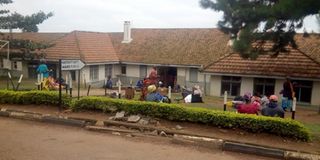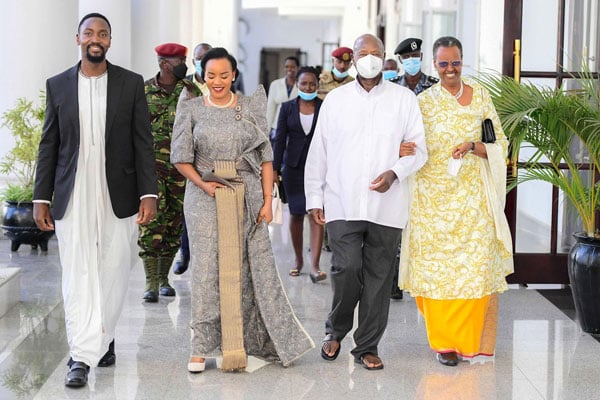Masaka hospital needs 35 more midwives

Crisis. Expectant mothers wait outside the Masaka Regional Referral Hospital maternity ward to be attended to recently. The hospital is experiencing shortage of midwives. PHOTO BY MOSES MUWULYA
What you need to know:
Background. Masaka hospital was constructed in 1927 as a treatment centre for syphilis, before it was later elevated to a referral facility in 1995 to offer services to the greater southern region districts.
MASAKA. The number of expectant mothers turning up for antenatal services has overwhelmed Masaka Regional Referral Hospital.
Dr Gonzaga Ssenyondo, the head of the gynaecology and obstetrics department at the hospital, says on average, they receive about 40 expectant mothers daily and about 1,200 monthly.
He says currently, the hospital’s maternity department has only 20 midwives, sparking fear that this could fuel maternal mortality.
The same staff attend to other mothers that visit the hospital for routine antenatal checkups and other ailments.
This means that if 10 midwives deliver about 40 mothers, each of them will have delivered about four mothers in a day.
Under normal circumstances, according to Dr Ssenyondo, one midwife is supposed to attend to about 20 mothers annually. However, at Masaka hospital, on average, each midwife attends to 400 women annually and many get overwhelmed.
The hospital management recommends the recruitment of 35 more midwives to bridge the staffing gap.
Dr Ssenyondo attributes the rising number of expectant mothers at the facility to the operational inefficiencies at the lower health centre IIIs and IVs in Masaka sub-region.
The notable inefficiencies include lack of fully functional theatres at health centre IVs to handle caesarian cases, lack of blood transfusion services and skilled personnel.
“Mothers move from as far as Sembabule, Kalungu and Bukomansimbi districts and in most cases they come late at the hospital with intricate cases that require urgent attention,” he says.
“The Ministry of Health (MoH) ought to consider us in a special way by getting us more midwives so as to handle the huge numbers. This shall enable mothers receive the urgently needed care and bring down maternal mortality cases,” Dr Ssenyondo stressed in a recent interview with Daily Monitor.
The midwives among other things have to monitor the mothers’ blood pressure and check on the progress of the baby before delivery, which makes them fully engaged.
“Worse still, not all mothers deliver normally, meaning that there is need for extra attention and care after operation,” Dr Ssenyondo adds.
When this reporter visited the hospital, some mothers who had delivered were sleeping on the floor and were susceptible to infections.
Others were queuing to access antenatal services.
“We have to wait for about 40 minutes to be attended to even if the case is urgent,” Ms Sukulati Namuli, an expectant mother who had been referred from Kyazanga Health Centra in Lwengo District, says.
Annually, the maternity wing at Masaka Regional Referral Hospitalconducts about 2,500 caesarian section cases, according to the hospital records. Health workers’ fatigue remains a common problem at the maternity department and staff work for 12 hours instead of eight hours.
Mr Edward Kabuye, the principal hospital administrator, says the MoH is still relying on old staff structure, which was developed when the facility was still small, stressing the need for a revised structure.
“A new staff structure needs to be conducted basing on the current number of expectant mothers registered by the facility,” Mr Kabuye says.
He says two more midwives have been posted to the facility and they are also planning to recall two others who had been deployed at other departments to help address the staffing gap. This, may not address the problem since the facility registers bigger numbers each day.
However, Mr Kabuye is optimistic that the new maternity and children complex currently under construction will solve space challenges.
One midwife, who spoke to this reporter on condition of anonymity, considering the sensitivity of the matter, noted that with the high influx of expectant mothers, the department deserves more midwives to relieve them of the huge patient load.
“Our workload is huge. Sometimes we are accused of being rude but so many factors contribute to it,” she says.
A report titled ‘Maternal Mortality review’ in three referral hospitals, which included Masaka Referral Hospital, revealed that between 2009-2011, about 300 deaths of mothers were recorded in Fort Portal, Masaka and Mulago hospitals.
The report, which was compiled by the Association of Gynecologist and Obstetrics in Uganda, was aimed at establishing why women continue to die in labour.
It further revealed that these mothers died during a time when health workers were fatigued or while changing their shift schedules.
Masaka hospital was constructed in 1927, as a treatment centre for syphilis, before it was later elevated to a referral status in 1995 to offer services to the greater southern region districts.
Since then, the hospital has been grappling with many challenges ranging from lack of space to accommodate the overwhelming numbers of patients, inadequate drugs and irregular power supply.



